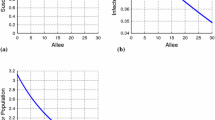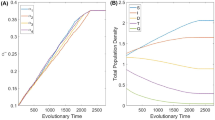Abstract
In this paper, we propose a mathematical model of viral infection in pest control. As the viral infection induces host lysis which releases more virus into the environment, on the average ‘κ’ viruses per host, κ∈(1,∞), so the ‘virus replication parameter’ is chosen as the main parameter on which the dynamics of the infection depends. There exists a threshold value κ 0 beyond which the infection persists in the system. Still for increasing the value of κ, the endemic equilibrium bifurcates towards a periodic solution, which essentially indicates that the viral pesticide has a density-dependent ‘numerical response’ component to its action. Investigation also includes the dependence of the process on predation of natural enemy into the system. A concluding discussion with numerical simulation of the model is also presented.
Similar content being viewed by others
References
Adams, J.R., Bonami, J.R., 1991. Atlas of Invertebrate Viruses. CRC, Boca Raton.
Amico, V.D., Baculoviruses, 1976. NEFES-Microbial Control, Hamden, CT, (www.nysaes.cornell.edu/ent/bio-control/pathogens/baculovirus.html).
Anderson, R.M., May, R.M., 1978. Regulation and stability of host-parasite interactions. I. Regulatory Processes. J. Anim. Ecol. 47, 219–247.
Banerjee, T.C., 1999. Population growth. In: Basu, D.K., Malik, A., Ghosh, A.R. (Eds.), Environment: Issues and Challenges, Academic Staff College, University of Burdwan (sponsored by University of Grant Commission), India.
Barbalat, I., 1959. Systems d’equations differentielles d’oscillations non lineares. Rev. Math. Pure Appl. 4, 267–270.
Birkhoff, G., Rota,G., 1989. Ordinary Differential Equation. 4th edn. Wiley, Canada.
Burge, H.D., Hussey, N.W., 1971. Microbial Control of Insects and Mites. Academic, New York.
Chattopadhyay, J., Arino, O., 1999. A prey-predator model with diseases in the prey. Nonlinear Anal. 36, 747–766.
Cory, J.S., Halis, M.L., Williams, T., 1994. Field trial of a genetically improved baculovirus insecticide. Nature 370, 138–140.
Dwyer, G., Dushoff, J., Elkinton, J.S., Burand, J.P., Lavin, S.A., 2002. Variation in susceptibility: lessons from an insect virus. In: Dieckmann, U., Metz, J.A.J., Sabelis, M.W., Sigmund, K. (Eds.), Adaptive dynamics of infectious diseases: in pursuit of virulence management, pp. 74–84. Cambridge Univ. Press, Cambridge.
Fenner, R., 1983. Biological control as exemplified by smallpox eradication and myxomatosis. Proc. Roy. Soc. Lond. B 218, 259–285.
Fenner, F., Ratcliff, F.N., 1965. Myxomatosis. Cambridge Univ. Press, Cambridge, p. 379.
Freedman, H.I., 1980. Determinstic Mathematical Models in Population Ecology. Dekker, New York.
Goh, B.S., Leitman, J., Vincent, T.L., 1980. Optimal epidemic programs for pest control. In: Goh, B.S. (Ed.), Management and Analysis of Biological Populations.
Grenfell, B.T., Dobson, A.P., 1995. Ecology of Infectious Diseases in Natural Populations. University Press, Cambridge.
Hadeler, K.P., Freedman, H.I., 1989. Prey-predator populations with parasite infection. J. Math. Biol. 27, 609–631.
Hails, R.S., 1997. Br. Crop Prot. Counc. Symp. Proc. 68, 53–62.
Hamilton, W.D., Axelrod, R., Tanese, R., 1990. Sexual reproduction as an adaptation to resist parasites: a review. Proc. Natl. Acad. Sci. USA 87, 3566–3573.
Holling C.S., 1959. The functional response of predator to prey density and its role in mimicry and population regulation. Mem. Entomol. Soc. Can. 45, 5.
Holmes, J.C., Bethel, W.M., 1972. Modification of intermediate host behaviour by parasites. In: Cunning, E.V., Wright, C.A. (Eds.), Behavioural Aspects of Parasite Transmission, Suppl. No. 1, Zool. J. Linnean Soc. pp. 129–149.
Huber, J., 1986. Use of Baculoviruses in pest management programs. In: Granados, R.R., Federici, B. (Eds.), The Biology of Baculoviruses, vol. II. CRC, Boca Raton.
Irving, P., 1997. Genetically engineered baculoviruses for forest insect management application: a Canadian forest service discussion paper, Natural resource Canada.
Jorgensen, L.A., Jorgensen, S.E., Nielsen, S.N., 2000. ECOTOX, Ecological Modelling and Ecotoxicology. Elsevier, Netherlands.
Kurstak, E., 1982. Microbial and Viral Pesticide. Dekker, New York.
Lacey, L.A., Goettel, M., 1995. Current developments in microbial control of insect pests and prospects for the early 21st century. Entomophaga 40, 3–27.
Lafferty, K.D., Morris, A.K., 1996. Altered behavior of parasitized killifish increases susceptibility to predation by bird final hosts. Ecology 77, 1390–1397.
Lewis, W.J., van Lenteren, J.C., Pathak, S.C., Tumlinson, J.H., 1997. A total system approach to sustainable pest management. Proc. Natl. Acad. Sci. USA 94, 12243–12248.
Nagumo, N., 1942. Uber die Lage der Integralkurven gewonlicher Differantialgleichungen. Proc. Phys. Math. Soc. J. 24, 551.
Poore, A.B., 1976. On the theory and application of the Hopf-Friedrichs bifurcation theory. Arch. Rat. Mech. Anal. 60, 371–393.
Thieme, H.R., 2003. Mathematics in Population Biology. Princeton University Press, Princeton.
Thomas, M.B., 1999. Ecological approaches and the development of “truly integrated” pest management. Proc. Nat. Acad. Sci. 96(11), 5944–5951.
Thomas, M.B., Wood, S.N., Lomer, C.J., 1995. Biological control of locusts and grasshoppers using a fungal pathogen: the importance of secondary cycling. Proc. Roy. Soc. Lond. Ser. B 259, 265–270.
Thomas, M.B., Blanford, S., Gbongboui, C., Lomer, C.J., 1998. Experimental studies to evaluate spray applications of a mycoinsecticide against the rice grasshopper, Hieroglyphus daganensis, in northern Benin. Entomol. Exp. Appl. 87, 93–102.
Vlak, J.M., 1993. Genetic engineering of baculoviruses for insect control. In: Oakeshott J., Whitten, M.J. (Eds.), Molecular Approaches to Fundamental and Applied Entomology. Springer, Berlin.
Waage, J.K., 1993. In agricultural and environmental challenges. In: Srivastava, J.P., Alderman, H. (Eds.), Proc. of the Thirteenth Agri. Sec. Symp., pp. 119–134. World bank, Washington.
Wood, S.N., Thomas, M.B., 1996. Space, time and persistence of virulent pathogens. Proc. Roy. Soc. Lond. Ser. B 263, 673–680.
Xiao, Y., Chen, L., 2001. Modelling and analysis of a prey-predator model with diseases in prey. Math. Biosci. 171, 59–82.
Author information
Authors and Affiliations
Corresponding author
Rights and permissions
About this article
Cite this article
Ghosh, S., Bhattacharyya, S. & Bhattacharya, D.K. The Role of Viral Infection in Pest Control: A Mathematical Study. Bull. Math. Biol. 69, 2649–2691 (2007). https://doi.org/10.1007/s11538-007-9235-8
Received:
Accepted:
Published:
Issue Date:
DOI: https://doi.org/10.1007/s11538-007-9235-8




